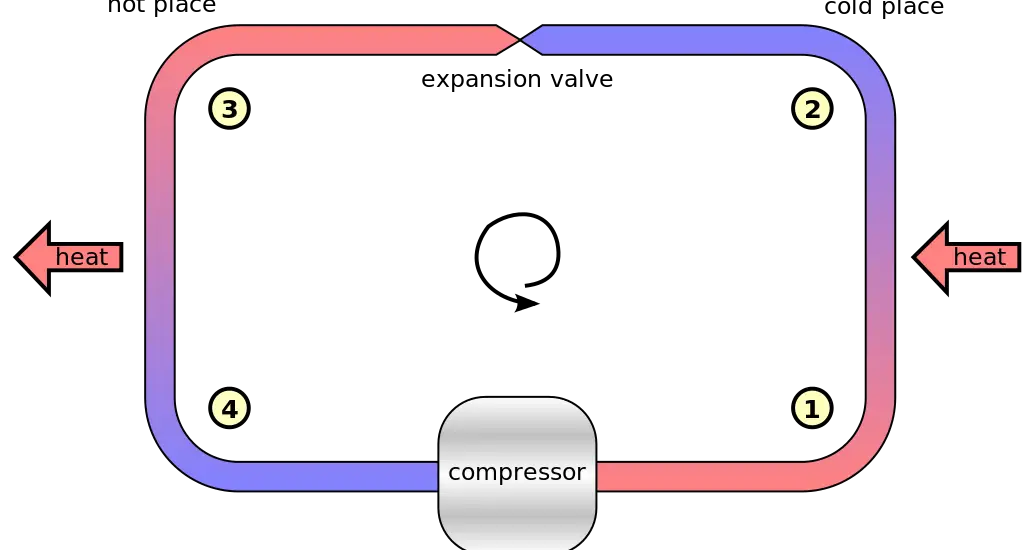In this article, we’ll break down the function of thermostatic expansion valve in refrigeration system in a step-by-step manner to reveal its critical role.

Table of Contents
The Core Function of Thermostatic Expansion Valve in Refrigeration System
At the heart of the refrigeration system, straddling the divide between the high-pressure side (comprising the compressor and the condenser) and the low-pressure side (featuring the evaporator), sits the thermostatic expansion valve (TXV or TEV). Its central role is to regulate the flow of refrigerant into the evaporator coil. But what does this entail?
Understanding the function of the thermostatic expansion valve in a refrigeration system goes beyond mere regulation. This valve maintains precise control of the refrigerant flow, guaranteeing that the right amount enters the evaporator.
It adjusts the flow rate based on the cooling load, which can fluctuate based on several factors including the external temperature and the amount of products stored in a refrigeration unit.
By ensuring a steady and adequate refrigerant flow, the TXV helps in preventing issues like flooding or starving the evaporator, phenomena that can greatly hamper the efficiency and performance of the refrigeration system.
In essence, it safeguards the system, helping it to adapt swiftly to changing conditions and maintain optimal operating conditions at all times.
How the Thermostatic Expansion Valve Operates
To comprehend how the thermostatic expansion valve operates in a refrigeration system, it is pivotal to delve deeper into its mechanistic intricacies. The valve functions based on two primary parameters: the temperature and the pressure of the refrigerant.
Here’s how it works step-by-step:
Sensing Bulb: The valve is equipped with a sensing bulb that is connected to the outlet of the evaporator. This bulb contains a fluid that expands or contracts based on the temperature it senses, sending a corresponding signal to the valve.
Pressure and Temperature Regulation: Based on the signals received from the sensing bulb, the valve modulates the refrigerant flow. If the temperature at the evaporator’s outlet is high, it infers that more cooling is needed and thus, it opens up to allow a greater flow of refrigerant. Conversely, if the temperature is low, it reduces the refrigerant flow to maintain the desired temperature levels.
Superheat Adjustment: An important function of the TXV is to control the superheat. Superheat is the temperature of the refrigerant above its boiling point. The TXV adjusts the refrigerant flow to maintain a desirable level of superheat, optimizing the performance of the refrigeration system.
In addition to these, the TXV also responds to the pressure changes, thereby continuously adjusting the flow of the refrigerant to ensure the system operates efficiently while preventing issues such as coil frosting or inadequate cooling. It’s a dynamic system, consistently working to keep the balance perfect and your environment cool.
This modus operandi of the TXV not only ensures that the refrigeration system responds appropriately to the prevailing conditions but also maintains a high level of energy efficiency. This, in turn, aids in prolonging the lifespan of the system while keeping energy bills at a reasonable level.
Check out these other articles…
How to Adjust Superheat on TXV: Your Easy-to-Follow Guide
How to Adjust Superheat and Subcooling: An Easy Guide
TXV HVAC: Your Comprehensive Guide
Bad TXV Valve Symptoms: Detecting & Resolving Early Signs
What is TXV Valve? Comprehensive 411 Guide
Benefits of a Well-functioning Thermostatic Expansion Valve
A TXV in good working condition brings a host of benefits.
It ensures the system achieves optimal cooling by maintaining the right refrigerant balance, thus preventing instances of over-cooling or under-cooling.
Furthermore, it safeguards the compressor from potential damages arising from fluctuating refrigerant levels, enhancing its lifespan.
Not to forget, a well-regulated refrigeration system through a properly functioning TXV invariably leads to reduced energy bills, making it a crucial component in efficient energy management.
Common Issues and Their Fixes
Despite its essential role, the TXV is not immune to issues. Common problems include clogging, generally due to impurities in the refrigerant, and unresponsiveness to temperature changes, which could be due to a faulty sensor bulb.
It is vital to schedule regular maintenance to check the valve’s condition and clean it to prevent clogs.